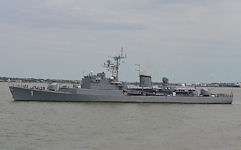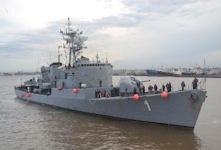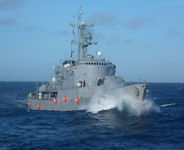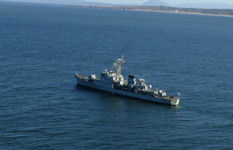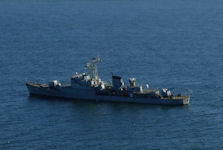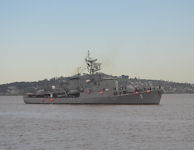Uruguay (Commandant Riviere) class
light ASW/patrol frigates
The class João Belo, also known as class Commander João Belo, is a series composed by four frigates of French design, identical to the class Commandant Rivière, but equipped with extra equipment and suitable habitability to operate in tropical climate. They were commissioned by the Portuguese Navy in 1964, the four ships of the class, were built in the shipyards of Nantes. They entered service between 1967 and 1969, and replaced the English frigates of class River and class Bay.
In the 1960s the Portuguese Navy was interested in acquiring British frigates of the Leander class, but due to British opposition to the dictatorial regime that existed in Portugal at the time, such an acquisition proved impossible. Portugal was then forced to acquire these frigates among the projects that were then available for the defense of the colonies in Africa, in the waters of Macao and Timor.
The frigates of class João Belo were Ships acquired by Portugal in the sixties. They were manufactured in the Shipyards of Nantes. In economic terms, Uruguay was favored when buying the frigates to Portugal. The agreement between the two countries included the training of Uruguayan crews by the Portuguese Navy in order to facilitate the adaptation to the systems used in frigates. The ships were sold with different equipment, including some improvements made in the decade of the 1990s when the frigates were modernized. The sale of the ships was part of the protocol of cooperation between both countries signed in September 2007, on the occasion of the visit to Portugal of President Tabaré Vázquez. The price paid is less than half of the US $30 million in which the Portuguese Ministry of Defense initially valued the vessels. With the sale of material launched more than 40 years ago, Portugal seeks to finance part of the purchase of new equipment for its Armed Forces.
The Navy reported that about 300 nautical miles off the coast of Cape Town in South Africa, the "Uruguay" and "Pedro Campbell" vessels collided on 14 May 2014, while they sailed the same way to that port, in order to begin their participation in a naval maneuver with armadas of other countries. There were "material damages" on the vessels, although they allowed them to continue sailing "safely" to their destination,
| Displacement: | 2,150-2,250 tons full load |
| Dimensions | 102.7 x 11.8-11.94 x 3.71-4.35 meters (337 x 39 x 14 feet) |
| Propulsion | 4 Main Motors Semt Pielstick Diesel 16000 HP, 2 axle lines |
| Electric power | 4 MGO generators (320 Kw each) |
| Maximum speed | 23.8-26 knots |
| Autonomy | 7920 NM (at 11 knots) |
| Crew | 159 |
| Surface Radar | Kelvin Heuges / DRVB 50 |
| Air search Radar | DRVB 22 |
| MAE | APECS |
| Communications | MF / HF / VHF / UHF / Capsat C |
| Navigation | GPS, Echo sounder |
| Sonar | SQS-17 hull, DUBA 3 attack |
| Fire Control | DRBC 32C |
| EW | ARBR 16 intercept |
| Armament |
|
| Number | Name | Year | Homeport | Notes |
| 1 | Uruguay | 1963/90 | Montevideo | Ex-C.Bourdais Inactive 2008 |
| 2 | General Artigas | 1962/88 | Montevideo | Ex-V.Schoelcher Inactive 27 Apr 2005 |
| 3 | Montevideo | 1962/91 | Montevideo | Ex-A.Charner Inactive 2008 |
| 1 | Uruguay | 1967/2008 | Montevideo | Ex-Cte. Jolo Bello |
| 2 | Cte. Pedro Campbell | 1969/2008 | Montevideo | Ex-Cte. Sacadura Cabral |
|
NEWSLETTER
|
| Join the GlobalSecurity.org mailing list |
|
|
|


